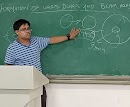Basic Theories
Understanding the relation between Heisenberg's Uncertainty principle and wave function
In my previous article, I explained the Heisenberg’sUncertainty principle. If you haven’t read it I recommend you to firstly read
that article and then come here.
To understand the relation between Heisenberg’s uncertainty
principle firstly we need to understand an example. Suppose you want to find
momentum of a particle as accurately as possible. By De Broglie’s equation we
know momentum of a particle depends on the wavelength of its wave function. So,
if we want to know wavelength, the wave function cannot be too localized (it should be spreaded), since
the wavelength of a localized wave is not precisely determined.
 |
| Spread Wave |
On the other hand, if we try to measure the position precisely,
then we need a localised wave. So, it’s a kind of obvious that we cannot have
localized and spread wave at the same time.
 |
| Localized Wave |
So, we compromise in the form of a
wave function that is partially localized and partially spread and provides
relatively precise value of both momentum and position.
 |
| Wave Packet |
This type of wave
function is called a wave packet. Thus, the Heisenberg’s Uncertainty principle
is a mere consequence of the wave function.
In my upcoming articles, I will also derive Heisenberg’s Uncertainty
principle both mathematically and logically so, don’t forget to subscribe to our website and follow me on social media for updates…..
You can directly talk with me on Instagram
To meet more physics Enthusiasts please join our Facebook Page
To meet more physics Enthusiasts please join our Facebook Page
Also for latest updates of my posts join me on Twitter
Thanks for reading.....
See you next time!!!
-Ratnadeep Das Choudhury
Founder and Writer of The Dynamic Frequency













0 Comments